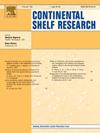Effects of consecutive dredging on the fish community of a tropical estuary
IF 2.1
3区 地球科学
Q2 OCEANOGRAPHY
引用次数: 0
Abstract
Dredging is a human activity that significantly alters aquatic habitats, potentially impacting ecosystem services such as artisanal fishing. This study aimed to evaluate changes in fish density in Buenaventura Bay in response to three dredging events that occurred between 2015 and 2021. Fish monitoring was conducted using artisanal trawl nets before, during, and after each dredging event, with annual sampling in two areas of the bay over the study period. The findings revealed species-specific responses: while species such as the catfish Cathorops multiradiatus and the sole Achirus kluzingeri benefited from dredging, the pygmy pufferfish Sphoeroides trichocephalus was negatively affected. Contrary to common assumptions in the literature, resident estuarine species were not necessarily the most negatively impacted but instead exhibited variable responses to dredging disturbances. The fish assemblage showed a shift towards species more tolerant to these impacts, highlighting a potential loss of ecosystem resilience. These changes could have long-term implications for the productivity of artisanal fisheries and the food security of local fishing communities.

连续疏浚对热带河口鱼类群落的影响
疏浚是一项人类活动,它会显著改变水生栖息地,潜在地影响生态系统服务,如手工捕鱼。本研究旨在评估2015年至2021年间发生的三次疏浚事件对布埃纳文图拉湾鱼类密度的影响。在每次疏浚活动之前、期间和之后,都使用手工拖网进行鱼类监测,并在研究期间每年在海湾的两个区域取样。研究结果揭示了物种特有的反应:虽然鲶鱼(如Cathorops multiradiatus)和kluzingeri Achirus)从疏浚中受益,但侏儒河豚(Sphoeroides trichocephalus)却受到了负面影响。与文献中常见的假设相反,居住的河口物种不一定受到最负面的影响,而是对疏浚干扰表现出不同的反应。鱼类组合显示出向更能忍受这些影响的物种的转变,突出了生态系统恢复能力的潜在丧失。这些变化可能对手工渔业的生产力和当地渔业社区的粮食安全产生长期影响。
本文章由计算机程序翻译,如有差异,请以英文原文为准。
求助全文
约1分钟内获得全文
求助全文
来源期刊

Continental Shelf Research
地学-海洋学
CiteScore
4.30
自引率
4.30%
发文量
136
审稿时长
6.1 months
期刊介绍:
Continental Shelf Research publishes articles dealing with the biological, chemical, geological and physical oceanography of the shallow marine environment, from coastal and estuarine waters out to the shelf break. The continental shelf is a critical environment within the land-ocean continuum, and many processes, functions and problems in the continental shelf are driven by terrestrial inputs transported through the rivers and estuaries to the coastal and continental shelf areas. Manuscripts that deal with these topics must make a clear link to the continental shelf. Examples of research areas include:
Physical sedimentology and geomorphology
Geochemistry of the coastal ocean (inorganic and organic)
Marine environment and anthropogenic effects
Interaction of physical dynamics with natural and manmade shoreline features
Benthic, phytoplankton and zooplankton ecology
Coastal water and sediment quality, and ecosystem health
Benthic-pelagic coupling (physical and biogeochemical)
Interactions between physical dynamics (waves, currents, mixing, etc.) and biogeochemical cycles
Estuarine, coastal and shelf sea modelling and process studies.
 求助内容:
求助内容: 应助结果提醒方式:
应助结果提醒方式:


